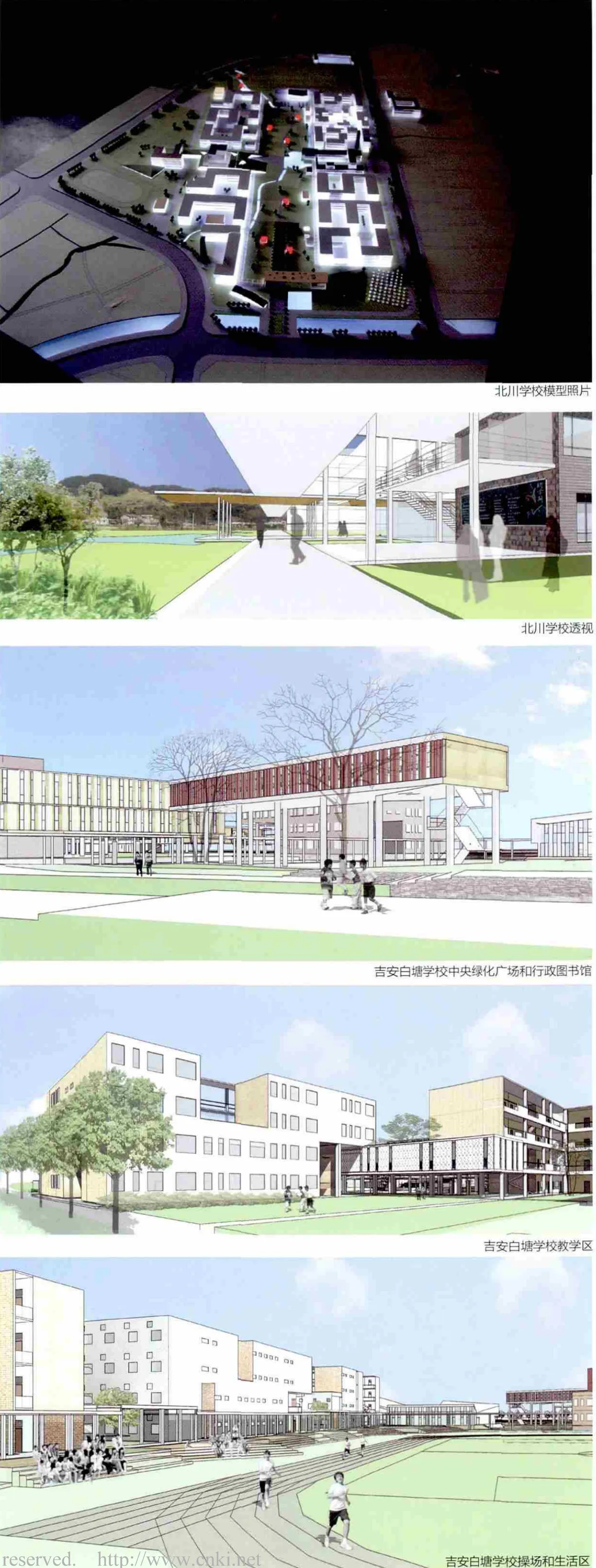北川中学到吉安白塘学校
2014-10-23王维仁,朱涛,张永和等
项目名称:北川中学校园规划/江西吉安白塘言爱基金学校
项目地点:四川新北川市齐鲁大道/江西吉安市白塘
建筑面积:73,000平方米/25,000平方米
项目时间:2008-2009(北川中学)/2010-2011(白塘学校)
建筑设计:-香港大学小区工作坊/王维仁建筑研究室/吉安市设计院(白塘学校)-王维仁/朱涛/香港大学建筑系硕士课程;王维仁/张永和/麻省理工学院建筑硕士课程(北川中学)
设计团队:王维仁/谢菁//许壮声/程骁/徐煑/谭咏雯(白塘学校)
Name:BeichuanMiddleSchool,Sichuan/YanaiBaitangSchool,Jian,Jiangxi
Location:Beichuan,SichuanProvince/Baitang,Jian,JiangxiProvince
FloorArea:73,000sm(BeichuanSchool)/25,000sm(YanaiBaitangSchool)
Completion:2008-2009(BeichuanSchool);2010-2011(BaitangSchool)
Design:CommunityProjectWorkshop,HKU/WangWeijen(YanaiBaitangSchool);WangWeijen/HKUMArchStudio/MITMArchStudio(BeichuanSchool);
Team:WangWeijen/XieJing/ThomasCheng/AndrewXu/MargieTam
北川中学:四川灾后重建
北川中学地块为典型的水稻田和鱼塘的农业地景,河川与规条灌溉渠道穿过.山丘之间的谷地坡面由东北向西南下降成为平地。设计着重学生人性的学习尺度与生活经验,将5200名学生的空间分为六个尺度适当的组团,由各个学院围塑成的大绿地成为延续自然地景的生态空间,更是人本成长具有象征意义的公民空间。如同衣服的尺码,在学校,院落,年级,班级与自我之间,这个设计希望找到空间自主的关键尺度,适合学生们大中小的尺度需求,形成一个个以院落为中间尺度的生活与学习圈。
可惜原有的方案在施工图阶段作了大幅的修改,失去了一次灾后教育空间改革的机会.两年之后,言爱基金会捐赠扶贫的吉安白塘学校,让我们实现了这个地景院落的校园空间的理想.
关键的尺度
吉安学校设计面临的挑战和北川中学一样:如何把一个中国典型的大尺度学校,配合着学生的年龄层,安排成几个尺度适当,具有空间认同感的小小区?怎么样的空间大小与组团关系,是适合六岁的儿童至十五岁的青少年成长的学习空间?如何在个体的价值与三千多个人的集体认同之间,寻找并加入一种中间的尺度,作为适合的学习与生活场所?如何突破以管理思维出发的,制式的功能分区,在“教学大楼,宿舍大楼,实验大楼”的思维之外,探索一种全新的,以人本学习出发的空间配置关系?
校园规划把一个大学校分成了三个学习组团,每一个组团形成三个相互联系的院落空间。每一个院落二十个班级可以是现有体制下的三个年级段:小学低年级,高年级,以及中学部;也可能是三个相对自主的小学院,各别拥有自己的院落广场。规划也把其他教学相关功能:特殊教室,实验室,音乐与艺术教室,办公室,都分散到这3组的学习空间里,成为院落之间的连接.生活空间的宿舍也分成三个与学习空间相对应的院落,活动交谊室,以及共享的大餐厅。学生们每天来往于各自的学习院落与生活院落之间,也经由共享的教室穿梭于不同年级的院落。
树林和地景

设计在校园中间保留了一条300米长50米宽的大片绿地与大树,贯穿校园由入口一路延伸到远方。想象原来这个地点的农业地景:溪流与水文穿过这一大片绿地,田埂鱼塘的痕迹转化为学生穿越绿地的小径,稻田的分割尺度成为校园活动与绿地植栽的规划模距:草地,树林,花园,菜圃,球场,坐椅,表演。大绿地的两侧的分别是教室与宿舍建筑,学生们穿越过这片延续自然生态与文化地景的绿地上,在课室与宿舍之间穿梭来往,上课下课,日出日落。
美国建筑师杰弗逊设计划的维吉尼亚大学中央的大绿地,将地景绿地提升为校园的空间象征,百年来成为无数校园规划的经典。学生在绿地树荫下上课讨论,读书休闲,运动,是校园最重要的文化公共空间。我们想象,言爱学校原有地块上的小溪与农田地景,都成为未来校园肌理的一部分,转化为绿意盎然的树林草地,学生们在这片文化与自然肌理的上探索成长,刻录生活的旋律。自然生态水塘与绿色的山丘不但成为校园轴线的端景,树林绿地的生态理念也成为学校的核心价值。
序列的合院
围绕在核心绿地东西两侧,是系列院落组成的合院空间;东侧是三个学习的教学院落,西侧是三个生活的宿舍院落。每一个四层楼高的院落除了间隔保证充分间距的阳光日照外,在量体设计上更以每两层为单元相互交错,在地面层或第三层形成挑空的开口平台。这些半户外的穿廊与平台成为在教室或寝室之外,学生重要的学习活空间。
教室与校舍之间的建筑空间,类似城市公共空间的街道广场与连廊;方院的串联与变化,连接院落之间的共享教室;南北向的自然绿地的延伸,穿过中央架空的图书馆,与行政楼和餐厅连结成的公共建筑序列;餐厅的天井小院引入自然光线和挑高的屋顶,由地景草坡转化而成的餐厅大门;连接操场的弧形台阶与运动设施房。
在未来学校大小层次的公共空间之中,学生们穿梭来往于教室间的廊道,与学院的广场之间,走入校园的绿地当中,与四周的远山自然连成一体。几年下来他们得到的是对社区公共空间与自然地景生态的尊重。学生们在自我,社群,与大自然的交织互动中,学习体验一个公民在社区里与他人共享的人文的或自然的公共空间。
Post-earthquake Re-habitation
With agriculture landscape of mostly rice paddy field and fishponds, the site for New Beichuan School has a river and several irrigation channels running through it.Mountains and a valley to its north-eastern corner provide a visual backdrop to the landscape fabric of the relatively f at site. The design subdivided a large school over 5000 students into 6 smaller collages each with their courtyard complexes for learning and living. Surrounded by courtyard buildings, A large common green in the center of campus transformed from existing fabric of agriculture landscape become symbolic that extending the school to nature. From campus to courtyard to classes and self, the design looks for appropriate scales needed for different types of learning and living.
The design un-fortunately had been drastically changed during the final stage of working drawing in 2009 to meet the standardized management pattern in China. The opportunity for educational reform through formulating a new campus model did not come true in this exercise of post-earthquake design. Two years later, a new project on designing Baitang School in Jian for Yanai Foundation gave us the opportunity to further develop the concept and f nally to put the idea into reality in 2011.
The Critical Scale
Similar to the Beichuan school, facing China’s typical large school program of over 3000 students per school, the design begins by asking what is the appropriate scale for student to build up their identity of spaces for teaching and living? What is the intermediate scale between collective identity and individual spirit better for developing ideas of civic society for future China? How do we moderate the scale of the school so to provide a quality learning environment, and also facilitating the way it could be better managed and sustained? What is the alternative option for school layout in China that is not only based on functional zoning and conveniences for management?
The design of Baitang School moderates a large school into three clusters of space for classroom and three for dormitory. With around 20 classes of students for each building complex sharing a courtyard space, each courtyard works like a college accommodating teaching, dinning, and living facilities for around 900 students. Other than general classrooms arranged in each collage’s courtyard, it will also have shared facilities for science laboratory, art, sport, library and administration linking three collages. By arranging functional components with proper circulation and logistic clustering, a clear sense of place logic is achieved and will be easily sustained in time.
The Common Green
By arranging six courtyards around a large scale of common green, the central mall of greenery becomes a symbolized landscape extending the campus to nature.Through incorporating existing water system and agriculture landscape into the new plan, the campus will not only sustain the original landscape fabric, but also provides ecologically responsible environment for the future. Transformed from the classic model of campus green in Thomas Jefferson’s University of Virginia, the shared value on nature and democracy become parts of the daily rhythm for students. By walking in-between the classroom and dorm across the common green, students learn and think along with the nature of woods, ponds and lawn, and their pattern of everyday experiences is not only functional but also poetic.
Scaled Courtyard
Sequence of U-shaped courtyard is adopted as modular prototype for each academic and dormitory block. With large openings and decks arranged in the mid-level of each courtyard, they moderate the four-story building into the scale of a two-story one.Connected by shared facilities, dif ferent academic courtyards are linked up to form a larger campus complex that accommodate classrooms and dormitories, as well as plazas, gardens and woods in-between the buildings. the campus establishes a system of open spaces with rich texture and logic of spatial hierarchy.
The design focuses on creating quality spaces for student’s learning and living,providing a campus with rich texture of daily experiences as well as an environment of humanity. By establishing a system of open spaces with scaled courtyard and greenery, the design also sustain the culture identity of the place by adopting local architecture typology and fabrics of landscape.



